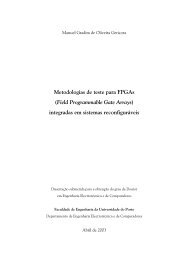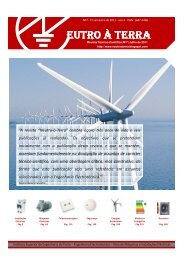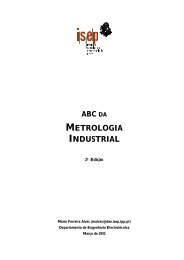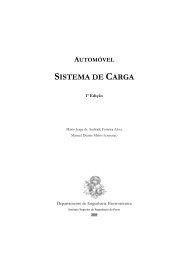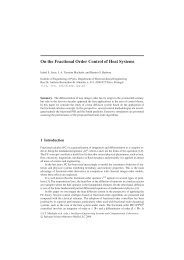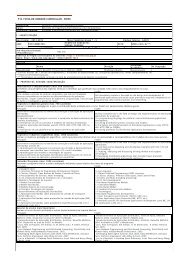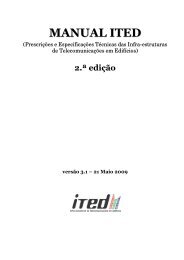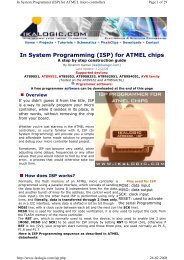describing function analysis of mechanical systems with nonlinear ...
describing function analysis of mechanical systems with nonlinear ...
describing function analysis of mechanical systems with nonlinear ...
Create successful ePaper yourself
Turn your PDF publications into a flip-book with our unique Google optimized e-Paper software.
0<br />
ω=30<br />
-2000 ω=40<br />
ω=50<br />
-4000<br />
ω=60<br />
linear<br />
F=50<br />
F=40<br />
F=30<br />
F=20<br />
10<br />
5<br />
Im (-1/N)<br />
-6000<br />
-8000<br />
-10000<br />
ω=70<br />
ω=80<br />
ω=90<br />
ω=100<br />
F=10<br />
-12000<br />
0 2000 4000 6000 8000 10000 12000 14000<br />
Re (-1/N)<br />
x(t)<br />
0<br />
-5<br />
-10<br />
65 70 75 80 85 90 95<br />
time (s)<br />
Fig. 3. Nyquist plot <strong>of</strong> −1/N(F,ω) for the system<br />
subjected to <strong>nonlinear</strong> friction and for an input<br />
force F = {10, 20, 30, 40, 50} N.<br />
Fig. 4 illustrates the variation <strong>of</strong> the Nyquist plots <strong>of</strong><br />
−1/N(F,ω) for the cases <strong>of</strong> the linear system and<br />
<strong>nonlinear</strong> friction. The log-log plots <strong>of</strong> Re{−1/N} and<br />
Im{−1/N} vs. the exciting frequency ω, for different<br />
values <strong>of</strong> the input force F = {10, 20, 30, 40, 50} N,<br />
reveal that we get results closer to the linear case the<br />
higher the excitation force F, particularly for the real<br />
component.<br />
|Re (-1/N)|<br />
10 4<br />
10 2<br />
10 0<br />
F=10 F=50<br />
Fig. 5. Time response <strong>of</strong> the output position x(t) <strong>of</strong><br />
the system <strong>with</strong> <strong>nonlinear</strong> friction <strong>with</strong> ω = 0.5<br />
rad/s, for F = 10 N (solid line) and F = 50 N<br />
(dashed line, scaled down by a factor <strong>of</strong> 10).<br />
Log(|F(x(t))|)<br />
10<br />
5<br />
0<br />
-5<br />
-10<br />
10 2<br />
10 1<br />
10 0<br />
ω (rad/s)<br />
10 -1<br />
10 -2<br />
0<br />
F=10 N<br />
1 2<br />
a)<br />
F=50 N<br />
3 4 5<br />
6 7<br />
8 9 10<br />
harmonic index k<br />
10 6 ω (rad/s)<br />
|Im (-1/N)|<br />
10 -2<br />
linear<br />
10 -4<br />
10 -2 10 -1 10 0 10 1 10 2<br />
10 4<br />
10 2<br />
F=10<br />
F=50<br />
10 0<br />
linear<br />
10 -2<br />
10 -4<br />
10 -2 10 -1 10 0 10 1 10 2<br />
10 6 ω (rad/s)<br />
Log(|F(x(t))|)<br />
10<br />
5<br />
0<br />
-5<br />
10 2<br />
10 1<br />
10 0<br />
ω (rad/s)<br />
10 -1<br />
10 -2<br />
0 1 2 3 4 5 6 7 8 9 10<br />
harmonic index k<br />
b)<br />
Fig. 6. Fourier transform <strong>of</strong> the output position x(t),<br />
F{x(t)}, over 20 cycles, vs. (ω, k), the exciting<br />
frequency ω and the harmonic frequency index k<br />
for: a) An input force F = 10 N and b) An input<br />
force F = 50 N.<br />
Fig. 4. Log-log plots <strong>of</strong> Re{−1/N} and Im{−1/N} vs.<br />
the exciting frequency ω, for F = {10, 20, 30, 40,<br />
50} N.<br />
Fig. 5 compares the time response for an input force<br />
<strong>of</strong> F = 10 N and F = 50 N. We conclude that for low<br />
forces the <strong>nonlinear</strong> effects <strong>of</strong> the static and Coulomb<br />
frictions are more significant, which is in accordance<br />
<strong>with</strong> the signal harmonic content F{x(t)} depicted in<br />
Fig.6.



